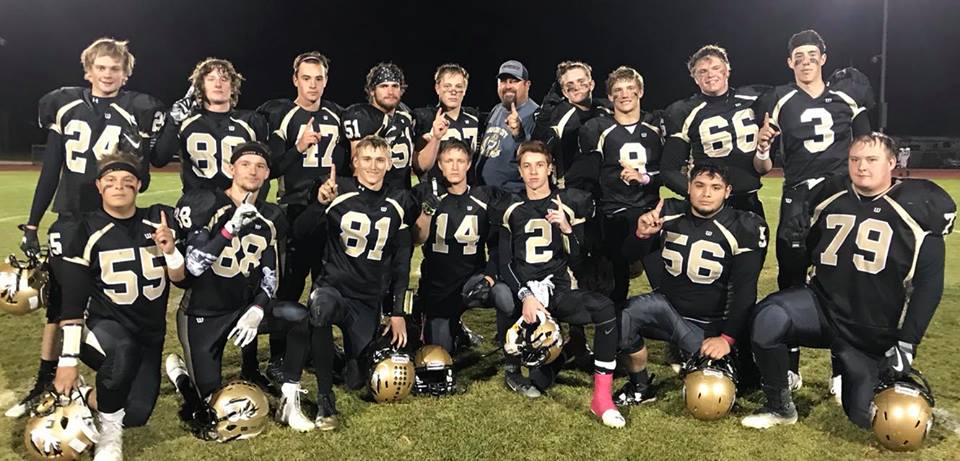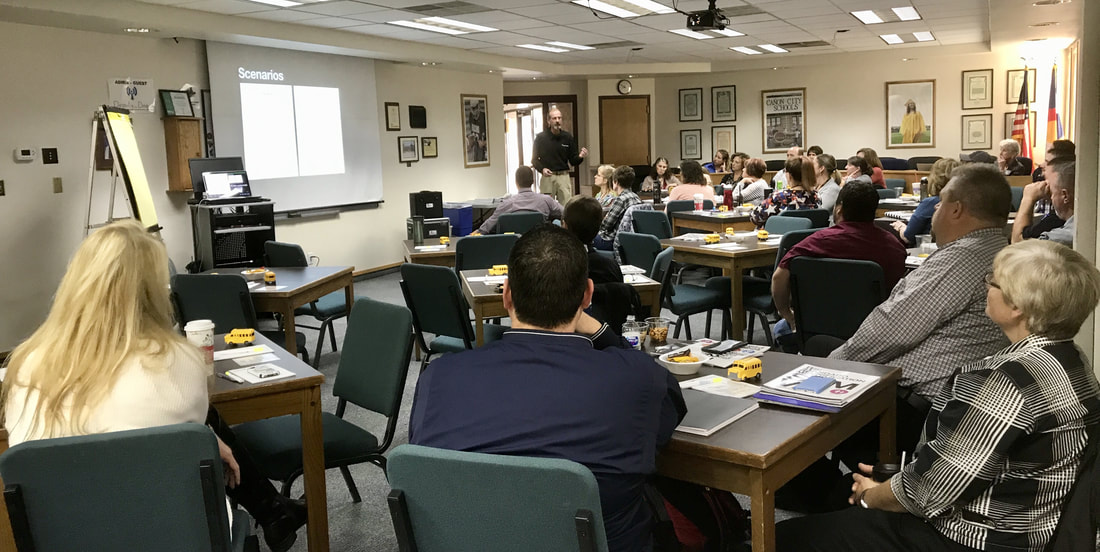Echoes from Cañon
Examples of Excellence
 CCHS Marching Band Director Josh Race celebrates a victory with drum majors Andre Konty, Chris Hudson, and Makenzie Konty.
CCHS Marching Band Director Josh Race celebrates a victory with drum majors Andre Konty, Chris Hudson, and Makenzie Konty.
Congratulations are due to Mr. Josh Race and the 135 Cañon City High School students who made the trek to Parker, Colorado on Monday October 30th to perform in the Class 3A Colorado Bandmasters Association State Championship competition. As you have no doubt heard, the Tiger Pride Marching Band walked away with a 73.1 rating to win the competition by a whopping point-and-a-half (trust me, this is quite a margin for such an event)! Despite a storied instrumental music history and tremendous community support for the arts, this is Cañon City High School’s first ever state marching championship, coming in only Mr. Race’s 3rd year as Director. I want to thank Mr. Race for his hard work and leadership. I also congratulate the Tiger Pride Marching Band. Thousands of hours of sweat, dedication, and constant rehearsal were invested in this accomplishment. We also need to thank our band booster and band parent organization, as I have never witnessed such outstanding adult support given to a group of students. The entire Cañon City community supported this accomplishment. From the nearly $40,000 in contributions offered to purchase new uniforms (because Mr. Race has attracted so many more participants), to the hundreds of supporters who braved bad weather to cheer on the students, to the glorious escort offered to the team by the Fremont County Sheriff’s Department and the Cañon City Police Department. Finally, the Southern Colorado Community Band also deserves credit for this accomplishment, as it was they who invested in Mr. Race’s college education by awarding him a scholarship when he graduated from Florence High School only a few years ago.
Director of Student Support Services Paula Buser organized a region-wide Standard Response Protocol training that took place on Thursday November 2nd. With support from the Colorado School District Self Insurance Pool, she brought John-Michael Keyes of the I Love U Guys foundation to present. Representatives from every Cañon City school were present, as well as from all RE-2 and RE-3 schools. Cañon City Volunteer Fire Department, Fremont County Sheriffs Officers, and Cañon City Police Department personnel participated as well. The training was simply excellent, as Mr. Keyes walked attendees through true life scenarios and even had participants observe a real-time drill that took place at Cañon City Middle School. Mr. Keyes is passionate about this crisis response work because he lost his daughter Emily in the tragic Platte Canyon High School shooting. Upon wrapping up the training Mr. Keyes informed Mrs. Buser that our “kids were fabulous and are clearly taking drills seriously.” “They are incredibly informed, and we just don’t see that in many places.”
On a final note this week, the Cañon City High School football team has quietly pieced together an outstanding season under coach Tom O’Rourke. The Tigers completed the regular season with a 9-1 record, ranked 4th in the state. I encourage everyone to watch for the release of the state playoff schedule and to support them in their pursuit of excellence.
Director of Student Support Services Paula Buser organized a region-wide Standard Response Protocol training that took place on Thursday November 2nd. With support from the Colorado School District Self Insurance Pool, she brought John-Michael Keyes of the I Love U Guys foundation to present. Representatives from every Cañon City school were present, as well as from all RE-2 and RE-3 schools. Cañon City Volunteer Fire Department, Fremont County Sheriffs Officers, and Cañon City Police Department personnel participated as well. The training was simply excellent, as Mr. Keyes walked attendees through true life scenarios and even had participants observe a real-time drill that took place at Cañon City Middle School. Mr. Keyes is passionate about this crisis response work because he lost his daughter Emily in the tragic Platte Canyon High School shooting. Upon wrapping up the training Mr. Keyes informed Mrs. Buser that our “kids were fabulous and are clearly taking drills seriously.” “They are incredibly informed, and we just don’t see that in many places.”
On a final note this week, the Cañon City High School football team has quietly pieced together an outstanding season under coach Tom O’Rourke. The Tigers completed the regular season with a 9-1 record, ranked 4th in the state. I encourage everyone to watch for the release of the state playoff schedule and to support them in their pursuit of excellence.
The Focus of Our Work
 Assistant Coach Dave Laughlin and some Tigers celebrate a big win over Woodland Park at the last home game of the regular season.
Assistant Coach Dave Laughlin and some Tigers celebrate a big win over Woodland Park at the last home game of the regular season.
Tuesday November 7th marks the culmination of this year’s mail in election process. To help folks understand the questions placed on the ballot by Cañon City Schools, I recently submitted a series of articles to local news media. For purposes of this publication I condensed these down to two articles, the second of which I am publishing this week.
Cañon City Schools has placed an operations override question November’s ballot. This is question 3A.
If 3A passes, we’ll be able to place an electronic device in the hands of every student to supplement their learning, starting with high schoolers in fall 2018. The district will maintain and support these devices, and upgrade them on a regular cycle for a period of 10 years. Doing this will also make it easier for us to replace outdated instructional materials because digital curriculum costs less to purchase, is more engaging for students, and is easier to update. Achieving these two priorities will use half of the additional operations dollars provided through the override on an annual basis.
Remaining override funds will allow us to address annual building maintenance and safety needs so we can get the most out of our investments. Funds will also be used to align employee compensation packages with those of other districts in our region so we can attract and retain the best educators and support staff to work with our children. A final area of focus will be to support services provided to Cañon City’s preschool children. Passage of 3A means an additional $85 thousand per year can be committed to enhance preschool learning opportunities and increase the number of children we serve.
Cañon City Schools has been unable to tackle these priorities outlined in question 3A because of significant funding cuts suffered at the hands of the 2008 recession. Though revenue has grown by the rate of inflation over the past several years, it has not, and likely never will, replace the $3.5 million annual cut that first hit in 2011. To add resources the district has pursued a string of unsustainable gifts, grants, and donations that are limited in the scope of their use and not always aligned with our greatest needs.
If 3A is voted down, our students, many who do not have access to modern digital devices and the internet, will continue to fall behind their peers in the use of technology for learning and career opportunities. They’ll continue to be taught using outdated curriculum materials. Hiring highly qualified teachers and support staff will become even more difficult than it is already, and so we’ll continue to lose highly trained and effective employees to school systems who compensate them at a higher rate. Finally, fewer of our most needy preschool age children have received the services they desperately need to start school on an even footing. In other words, nothing will change.
Ballot question 3B asks citizens to invest $18.2 million to provide $51.9 million in building improvements, roughly a 70% discount on construction and a 200% instant return on investment. Colorado’s Building Excellent Schools Today program, where most legalized marijuana tax revenues are allocated, will allow us to make building envelope and safety upgrades to Cañon City High School, Cañon Exploratory School, Harrison K-8, Lincoln School of Science and Technology, and McKinley Elementary, pay off the Mountain View Core Knowledge Charter School facility loan, and build brand new Washington Elementary and Cañon City Middle School facilities.
Cañon City Schools has placed an operations override question November’s ballot. This is question 3A.
If 3A passes, we’ll be able to place an electronic device in the hands of every student to supplement their learning, starting with high schoolers in fall 2018. The district will maintain and support these devices, and upgrade them on a regular cycle for a period of 10 years. Doing this will also make it easier for us to replace outdated instructional materials because digital curriculum costs less to purchase, is more engaging for students, and is easier to update. Achieving these two priorities will use half of the additional operations dollars provided through the override on an annual basis.
Remaining override funds will allow us to address annual building maintenance and safety needs so we can get the most out of our investments. Funds will also be used to align employee compensation packages with those of other districts in our region so we can attract and retain the best educators and support staff to work with our children. A final area of focus will be to support services provided to Cañon City’s preschool children. Passage of 3A means an additional $85 thousand per year can be committed to enhance preschool learning opportunities and increase the number of children we serve.
Cañon City Schools has been unable to tackle these priorities outlined in question 3A because of significant funding cuts suffered at the hands of the 2008 recession. Though revenue has grown by the rate of inflation over the past several years, it has not, and likely never will, replace the $3.5 million annual cut that first hit in 2011. To add resources the district has pursued a string of unsustainable gifts, grants, and donations that are limited in the scope of their use and not always aligned with our greatest needs.
If 3A is voted down, our students, many who do not have access to modern digital devices and the internet, will continue to fall behind their peers in the use of technology for learning and career opportunities. They’ll continue to be taught using outdated curriculum materials. Hiring highly qualified teachers and support staff will become even more difficult than it is already, and so we’ll continue to lose highly trained and effective employees to school systems who compensate them at a higher rate. Finally, fewer of our most needy preschool age children have received the services they desperately need to start school on an even footing. In other words, nothing will change.
Ballot question 3B asks citizens to invest $18.2 million to provide $51.9 million in building improvements, roughly a 70% discount on construction and a 200% instant return on investment. Colorado’s Building Excellent Schools Today program, where most legalized marijuana tax revenues are allocated, will allow us to make building envelope and safety upgrades to Cañon City High School, Cañon Exploratory School, Harrison K-8, Lincoln School of Science and Technology, and McKinley Elementary, pay off the Mountain View Core Knowledge Charter School facility loan, and build brand new Washington Elementary and Cañon City Middle School facilities.
 I Luv U Guys foundation director John-Michael Keyes shares his knowledge of Standard Response Protocol in crisis situations with RE-1, RE-2, and RE-3 personnel.
I Luv U Guys foundation director John-Michael Keyes shares his knowledge of Standard Response Protocol in crisis situations with RE-1, RE-2, and RE-3 personnel.
Why does the school district need to address its building deficiencies through 3B? This is the way Colorado’s education finance system is designed. Districts receive per-pupil allocations on a yearly basis. Dollars are budgeted to pay staff, purchase resources, transport kids, heat and cool buildings, and address minor maintenance projects. They are not intended to finance large-scale building improvements and school construction.
Cañon City taxpayers have a history of supporting the construction and upgrade of facilities. Our very first school, named after George Washington, was built in 1880 with voter approval. It was replaced in 1950 by the current Washington Elementary facility that now sits at the corner 9th and College.
Our most recent project, approved by the electorate in the fall of 2003 by a 2-1 margin, resulted in the construction of the new Harrison K-8 facility, a modern wing at Cañon City High School, and a variety of minor improvements at other buildings at a cost of $26 million. At that time, we secured $26 million in improvements for $26 million. Taxpayers are in the 14th year of a 20-year repayment cycle for this.
By contrast, 2017’s question 3B will leverage an $18.2 million investment into $51.9 million in improvements.
Is the work proposed in 3B truly necessary? To be awarded a BEST grant to replace an existing school you must produce evidence it will be useful for the foreseeable future. BEST relies on Colorado Department of Local Affairs Community Demographic Profile Data. Fremont County’s profile anticipates population growth of just under 5,000 residents from 2015 to 2020, with another 4,500 new residents added between 2020 and 2025. School-age child population is expected to increase by 1,500 between now and 2025. With two-thirds of these new students likely to attend Cañon City Schools, this more than justifies a need for the new facilities we have proposed.
Our Board of Education has clearly stated should 3B fail it will need to close a school, most likely Washington because of its pressing structural issues. This will require changing attendance boundaries, transporting more students on buses, and moving additional children to the Cañon City Middle School facility already not up to the task of modern education. Operations costs could be saved by closing a school, and doing so will get children out of harm's way. However, those savings will be offset by increased transportation expenditures and the district has no funds available to demolish Washington, so that building will sit vacant for years to come.
No matter how you feel about these questions, I encourage you to vote.
Cañon City taxpayers have a history of supporting the construction and upgrade of facilities. Our very first school, named after George Washington, was built in 1880 with voter approval. It was replaced in 1950 by the current Washington Elementary facility that now sits at the corner 9th and College.
Our most recent project, approved by the electorate in the fall of 2003 by a 2-1 margin, resulted in the construction of the new Harrison K-8 facility, a modern wing at Cañon City High School, and a variety of minor improvements at other buildings at a cost of $26 million. At that time, we secured $26 million in improvements for $26 million. Taxpayers are in the 14th year of a 20-year repayment cycle for this.
By contrast, 2017’s question 3B will leverage an $18.2 million investment into $51.9 million in improvements.
Is the work proposed in 3B truly necessary? To be awarded a BEST grant to replace an existing school you must produce evidence it will be useful for the foreseeable future. BEST relies on Colorado Department of Local Affairs Community Demographic Profile Data. Fremont County’s profile anticipates population growth of just under 5,000 residents from 2015 to 2020, with another 4,500 new residents added between 2020 and 2025. School-age child population is expected to increase by 1,500 between now and 2025. With two-thirds of these new students likely to attend Cañon City Schools, this more than justifies a need for the new facilities we have proposed.
Our Board of Education has clearly stated should 3B fail it will need to close a school, most likely Washington because of its pressing structural issues. This will require changing attendance boundaries, transporting more students on buses, and moving additional children to the Cañon City Middle School facility already not up to the task of modern education. Operations costs could be saved by closing a school, and doing so will get children out of harm's way. However, those savings will be offset by increased transportation expenditures and the district has no funds available to demolish Washington, so that building will sit vacant for years to come.
No matter how you feel about these questions, I encourage you to vote.
Last Week

On Monday, along with Cañon City High School Principal Bill Summers, I had the honor of being a keynote presenter at the Colorado Department of Education Graduation Guidelines Summit in Thornton. We shared how Cañon City High School is transforming to a career pathways school while working to meet updated Colorado high school graduation requirements. That afternoon I drove to Parker to cheer on the top seeded Tiger Pride Marching Band as they performed their state championship winning routine. I remained in the Denver area on Tuesday morning to attend a Colorado Safe Schools Resource Center work group meeting on how best to notify parents when tragedy strikes a school. On Wednesday, Director of Finance Buddy Lambrecht, Director of Instruction Adam Hartman, and I met to allocate the Title VB Dollars we were finally awarded. Though the dollars are greatly appreciated, this year’s allocation was $11,000 less than what we have traditionally received in the past. During the remainder of the week I attended a central office staff meeting, an operations staff meeting, a student expulsion hearing, a CCEA leader touching base meeting, and I made a Friday appearance on KRLN’s Morning Line.
This Week

I have a surprisingly open schedule for Monday and Tuesday of the coming week. On Wednesday morning, I’ll start my day in a Washington Elementary staff meeting to discuss election results and next steps. In fact, the bulk of the work I engage in for the next several years will be determined when all votes are counted Tuesday evening. If 3A is approved, we’ll initiate processes required to put a keyboard and screen device in the hands of every Cañon City High School student by the beginning of the 2018-19 school year. If 3B is approved, we’ll get right to work choosing a construction method, hiring an owner’s representative, an architect, and a builder, and refining our school construction grant applications prior to the February submission deadline. We’ll also begin making plans to install $7.5 million in building improvements across five of our schools in time for the start of the 2018-19 school year. If 3B fails, our major task will be to prepare information and options for the Board of Education to consider as it follows through with its promise to close a school and change attendance boundaries.
During the latter part of the week I’ll attend a Regional Wellness Advisory Team meeting, a CCHS Parent Advisory Committee meeting, a regional manager’s meeting, and several touching base meetings with our literacy team.
Thanks for listening once again!
George S. Welsh
During the latter part of the week I’ll attend a Regional Wellness Advisory Team meeting, a CCHS Parent Advisory Committee meeting, a regional manager’s meeting, and several touching base meetings with our literacy team.
Thanks for listening once again!
George S. Welsh
